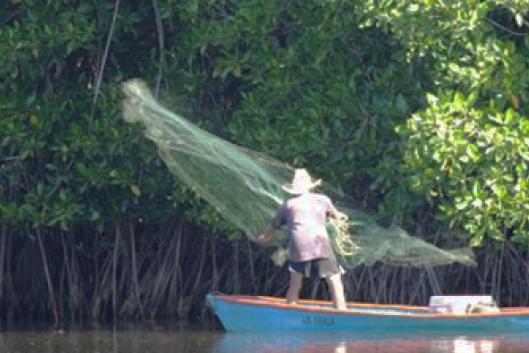FIFA is a for-profit organization which, through its leaders and a small group of corporations, merchandises the world’s most popular sport, football. FIFA and its commercial partners earn billions of dollars – tax-free - from the organization of the World Cup every four years, but they also generate a number of negative impacts. The construction of stadiums and complementary infrastructure, such as the transport systems required by FIFA, led tothe displacement of nearly 200.000 Brazilians. This estimate was disclosed by the organization representing the 12 grassroots committees from the World Cup host-cities in Brazil, which, even now that the tournament is over, is still in the difficult struggle for justice, seeking reparations for some of the violations people were subject to over the last years.
Surprisingly enough, the World Cup is related to forests and REDD (Reducing Emissions from Deforestation and Forest Degradation). This is because, among the many impacts caused by the World Cup in Brazil, FIFA has announced that it intends to “compensate” for part of the 1.4 million tons of CO2 emissions generated by the event, in particular those resulting from domestic and international air transport. One way in which FIFA aims to achieve this is through the purchase of carbon emission reduction credits arising from four projects in the voluntary carbon market. One of them is the REDD Project in Purus, in the Brazilian state of Acre, which happens to be one of the projects whose negative impacts were reported last year by WRM and the NGO RepórterBrasil (1). On-site visits showed that the families who supposedly were the project beneficiaries had almost no knowledge about the REDD project despite having to face a series of constraints imposed on their way of life since the project’s implementation. Even so, the project was certified by two voluntary certification systems called VCS and CCB. The certification is supposed to guarantee the project’s “social and environmental sustainability”.
It is known today that the promoters of mega-events, such as FIFA and other state, corporate or NGO actors, interested in commercializing nature and investing in mechanisms to “offset” emissions, are buying REDD credits and publicising their efforts in order to keep afloat the idea that the system can work. This is happening even though an analysis of REDD demonstrates that it is a false solution to the climate crisis, and the reality on the ground of pilot projects hasshown that REDD is not capable of halting deforestation, which poses further problems for local communities.
Moreover, the trend of voluntary markets, where REDD credits are currently sold and bought, shows that the carbon business is not working very well. According to the annualreports of the information platform “Ecosystem Services” of the initiative Forest Trends, the volume of carbon credits in the voluntary market fell by nearly 50% in 2013 compared to 2012. Although the report argues that REDD has had the biggest success in the carbon market, prices are so low (average of US$3 per credit) that the only projects that will be implemented are those that prohibit shifting cultivation and subsistence agriculture. The devastating impacts of this type of REDD project on the communities that depend on these forms of agriculture are well known. Although the Forest Trends report depicts REDD as a success, the market is small and impracticable. To keep REDD afloat, governments are increasingly interfering –using public money– with the objective to save it. One clear example is the significant financial transaction between the German Development Bank KfW and the government of Acre, in Brazil (2).
As the growth prospects of the REDD market are poor, its promoters seek new ways to insist on the same idea. They seem to think that, if REDD does not work in forests, then the proposal of a “Landscape REDD”, including agriculture, in particular the carbon “stored” in the crops and soils, may succeed in attracting new investors. And if the amount of carbon that forests and the “landscape”can “store” is not considered large enough, “Blue REDD” –promoted in coastal areas, rich in mangrove forests – offers the promise of absorbing much more carbon than inland forests. This WRM bulletin aims to inform aboutthese new trends in REDD.
July also marks the “International Mangrove Action Day.” RedManglar International, which supports and works with the communities that depend on mangroves, affirms, especially on this Day, that the defence of mangroves is essential for ensuring the food sovereignty of these communities, threatened by exploitation and the privatization of their lands by companies. RedManglar advocates that mangroves should not be included in REDD programmes and/or other initiatives of the so-called “green economy”, in the light of evident violations of the rights of local populations generated by these programmes, which in any case do not represent a real solution to climate change. To confront the privatization implied by REDD programmes, RedManglar advocates the need to promote, support and ensure the collective management of fishing and coastal communities’ territories (3).
In order to defend these communities that are under threat, now also by REDD projects, we need to confront the power of corporations and put pressure on the governments that support REDD. To that effect, important advances were made in Geneva, Switzerland, in late June, for all the organizations committed to this struggle: despite the attempts of the Northern governments to prevent it, the UN Human Rights Council (HRC) approved a resolution to create an intergovernmental working team to discuss an international legally binding instrument to regulate, in international human rights law, the activities of transnational corporations and other business enterprises (4).
The game has not been won yet with that decision but it is a “great goal” against the interests of large corporations and their allies.
(1) http://wrm.org.uy/pt/files/2014/01/Consideracoes_sobre_um_projeto_privado_de_REDD_no_Acre.pdf and also http://reporterbrasil.org.br/2013/12/projetos-de-carbono-no-acre-ameacam-direito-a-terra/
(2) http://www.forest-trends.org/vcm2014.php
(3) http://redmanglar.org/sitio/
(4) http://daccess-dds-ny.un.org/doc/UNDOC/LTD/G14/064/48/PDF/G1406448.pdf?OpenElement
